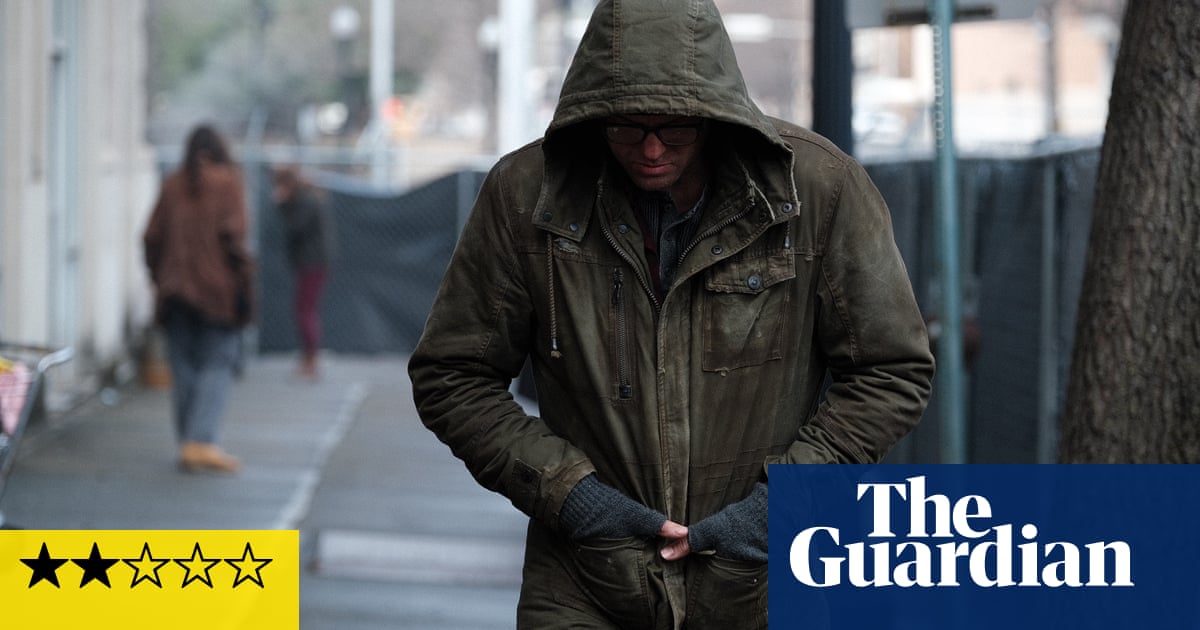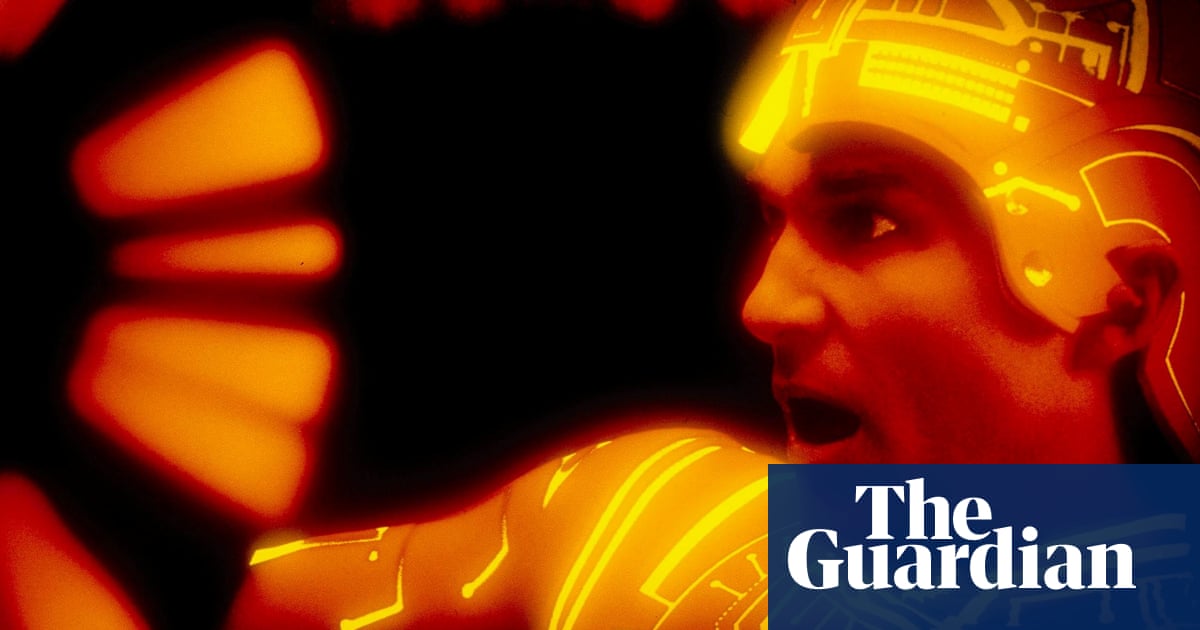
f you think you’ve never seen Simon Stålenhag’s art before, you could well be wrong. His paintings often turn up online under headlines such as This Art Is Cool: Imagining a Dystopian Sweden Full of Robots and Dinosaurs, where people marvel at his beautiful and haunting melding of sci-fi and suburbia: rural towns where children spend listless afternoons exploring rusting robot skeletons, and giant cooling towers haunt the horizon. On his Instagram account, where a painting of a petrol station at dusk can get thousands of likes, fans from all over the world write to tell him that his landscapes look just like their back yards, from Minnesota to Norway – just with a few more flying cars than they remember.
But if you think Stålenhag’s art is his prediction for humanity, you’d be wrong, too. None of his art is in future but the past; specifically his 80s childhood on Färingsö, a large island located in Sweden’s Lake Mälaren. Now 36, he lives just two kilometres from the house where he grew up. When we speak, he shows me the view and it’s grey, grey, grey: colossal skies, austere plains of murky grass. It’s desolate and beautiful, just like his art.
“Sweden is flat and kind of boring,” he says, gazing out of the window. “But I think the boring parts are exciting. I’ve always disliked overly dramatic aesthetics. When I went to the US for the first time, my eyes couldn’t even process the Disneyesque landscapes.” Robots and dinosaurs make people see past the boring flatness and find something beautiful, he says: “If I just painted a field in April, no one would look.”
Stålenhag wrote his most famous book, Tales from the Loop, because fans were sending him stories they’d set in his paintings. He was appalled. “I was like, ‘This won’t do! You have to know [it] exactly as it happened to me.’ They were too far out, too dystopian,” he says. “The difference between dystopia and futurism, for me, is that there is hot chocolate waiting for you at home in my world.”
Tales from the Loop is set in an alternative history, one where the second world war encouraged more research into nuclear technology; which then birthed new branches of experimental physics; which in turn lead to the construction a giant particle accelerator in rural Sweden that is dubbed “Slingan” by the locals, or “The Loop”. By the time it is shut down in 1994, it has shaped a generation of children, to whom robots, particle guns and airships are as quotidian as homework and teatime. There’s little plot in the often very short stories, which are as fleeting as a half-recalled memory: two twins accidentally swap bodies (their parents never notice), a break in space and time sees trilobites take over the school gym, a standoff between police and a bolshie child wielding a robotic glove. When a $10,000 crowdfunding campaign was set up in 2015 to publish the book, it raised $320,000 (£255,000). It has since spawned a sequel, board games and now an Amazon Prime show starring Jonathan Pryce and Rebecca Hall.
Remarkably, Stålenhag never trained as an artist. He learned first from watching his grandfather, then from obsessing over Swedish landscape artists including Bruno Liljefors and Lars Jonsson. In his teens he found the work of Pink Floyd cover artist Storm Thorgerson, then Hollywood sci-fi concept artists such as Ralph McQuarrie (Star Wars, ET) and Syd Mead (Blade Runner, Aliens, Tron). In his 20s, he learned on the job as a concept artist for a gaming studio, where he left behind gouache for digital painting. “Before then, I didn’t know how to paint robots or dinosaurs but the more confident I got, the more I wanted to use those skills. It’s like learning a chord and suddenly it is in all your songs,” he says. “It wasn’t an intellectual choice. I just wanted to do it.”
It was similarly instinctual, he says, to return to his childhood, and he’s never left it since, painting and repainting his backyard like Monet and his water lilies. “I knew I wanted to write Tales from the Loop before I even wrote a word. I just got better at painting. My artistic ideas are exactly the same as they were in my teens. I’ve always wanted to be here. I work better in remote places – self-isolating is nothing to me.”
When we speak, he hasn’t visited Stockholm for weeks. He worries that people in his area, where the greatest vector for disease is the local convenience store, aren’t taking the coronavirus outbreak seriously. “It’s scary. There is no nation on earth that has the capacity to deal with that kind of overload. The worst thing is, if we manage to flatten the curve, people will say we overreacted. If we don’t, then we didn’t do enough. I feel like I’m watching a hockey game, where you’re nervous about every little thing that happens. What a weird time to be alive.”
In both the book and the show, a thin membrane separates the world of children and that of adults, who have a better notion of what might be going on inside the depths of the Loop. In one story, Stålenhag’s alter-ego narrator tells us: “Rumour had it that they were trying to create machines that could feel and reason. Apparently they made progress; they were unable to stop prototypes escaping on several occasions.” In the next story, “an oily, sad little tin-can thing” is found nervously lurking by child-Stålenhag in the back yard; when his father comes out, “it is gone in three bounds”.
There is something childlike about Stålenhag, who bounds around the house showing me paintings. “I don’t feel like an adult,” he says later. “I like kids because I don’t think they know secrets. They’re just oblivious enough. It is important that adults exist, so kids can stay oblivious, but I’ve always felt more sympathetic to young people because they have fresh eyes. Teenagers have good bullshit detectors. To be progressive and liberal is to be ready for the next generation to call you out on your bullshit. It is really important to listen to young people. There is nothing I hate more than adults whose only argument is, ‘Respect your elders!’. No, please don’t!”
He admires his fellow Swede Greta Thunberg, and is baffled by her detractors. “She doesn’t say anything controversial at all and gets called brainwashed. You’d have to be crazy to think that.”
Speaking to Stalenhåg, you sense there is a political firebrand waiting to burst out. He flits from morals to pornography, advertising to the decline of democracy, and the conservatism he sees in his country. “Sweden is super-racist, because it is so white. We’ve never had to coexist with anyone different to us, so racism is bubbling up everywhere. The politicians say, ‘Don’t bring in the refugees, help them at the border’. They’re trying to morally justify how they think, but that is not how human suffering works. If you think ‘We, in this nation, have no obligation to those in that nation’, you subscribe to a simplistic idea of humanity. But this is the world we live in.”
However, he looks alarmed at the suggestion that this political awareness is the reason people see predictions of our future decline in his paintings. “It can ruin the art to be too unambiguous,” he says.
But people loved your painting of an army of colossal robo-Trumps, I say.
“No, no! I wouldn’t do that kind of art seriously,” he protests. “It’s not interesting. Painting is not intellectual for me, it is emotional. I have no training in art, I have experience. When I paint, I don’t analyse it.”
Even with the show now out in the world, he still seems surprised that his childhood memories became a TV project. He likes the show for the reason many will – it is strange, quiet and slow, noticeably so for one made by a big-budget US producer. “I would have really hated to see an artificial plot put in the world but there was no studio pressure to put in a bad guy. I am very happy with it,” he says.
Stålenhag wasn’t involved in the production of the series, but he spent five days on the set in Canada. “I went from here,” he says, gesturing at the flat Swedish landscape, “flew 20 hours and ended up somewhere that looks exactly the same. Not much bang for your buck.”
Tales from the Loop is published by Simon & Schuster UK. The adaptation is now available to stream on Amazon Prime.












